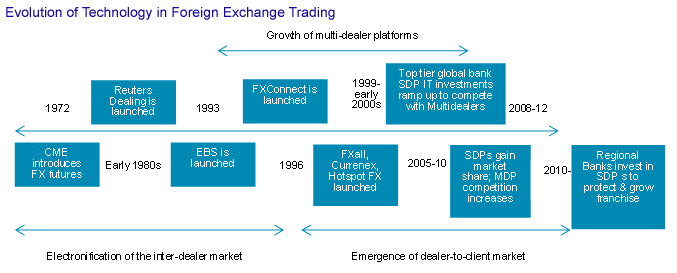The market for FX trading platforms is likely to become even more competitive as market segments blur. Improvements in technology and regulatory drivers are altering the competitive landscape.
In the report FX Trading Platforms: Models Converge and Competition Heats Up, Celent illustrates the evolution of foreign exchange trading platforms and resulting market structure due to regulatory and technology derivers. Key themes observed among FX platform providers are:
- Increasing competition among interdealer platforms.
- Increasing competition between single-dealer platforms and multidealer platforms.
- Regional banks upgrading single-dealer platforms to protect and grow market share.
- Expansion of product and client coverage by FX platform providers.
As a result of these themes, the traditional segmentation of interdealer, dealer-to-client, and retail market is blurring, with retail platforms going after the institutional market. At the same time, Institutional multidealer platforms operating in the dealer-to-client market are going after both ends of the market (interdealer and retail). Moreover, Interdealer platforms are acquiring dealer-to-client platforms.

“Regulations will be an important driver of change for the FX platform market,” says David Easthope, senior vice president of Celent’s Securities & Investments practice and coauthor of the report. “Regulations are discouraging large banks in principal-based trading and will result in more of them focusing on an execution-based agency approach.”
“Significant reduction in platform development time and cost has meant the barrier to entry for new platforms has been lowered,” says Arin Ray, an analyst with Celent’s Securities & Investments practice and coauthor of the report. “However, in an already crowded market, entrants will have to position themselves to attract volume and market share.”
The report begins with an overview of the FX market, looking at turnover composition and execution preferences. It then discusses the evolution of FX trading platforms over the last decade, and identifies the latest emerging trends in this area. In doing so, the report discusses 15 different FX trading platforms (interdealer, single-dealer, multidealer). Based on the analysis, the report sketches Celent’s outlook of how the future is likely to unfold for FX trading platforms.





